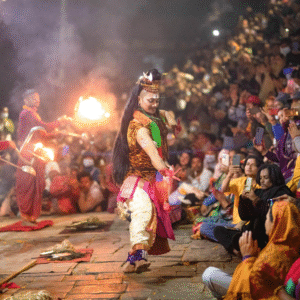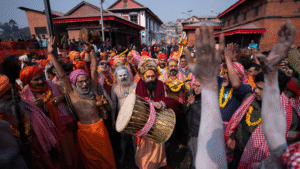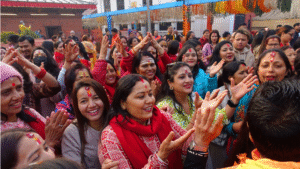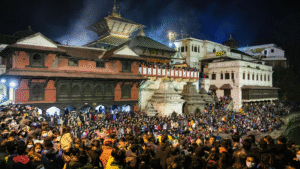16-year-old Binita from the Nepali Newsroom explains how people celebrate one of Hinduism’s most important festivals

Hindu priests offer prayers to Shiva during the Mahashivaratri festival at Pashupatinath Temple, Kathmandu.
Picture by: ZUMA Press, Inc. | Alamy
Article link copied.
September 12, 2025
Mahashivaratri: A festival where tradition meets modern thinking

Mahashivaratri, one of the biggest festivals within Hinduism, is celebrated all over Nepal during the month of Falgun according to the Nepali calendar (in February or early March in the Western calendar).
Mahashivarathri, meaning “The Great Night of Shiva”, is dedicated to Lord Shiva, the creator and destroyer of this world according to the Hindu religion. It is also considered the day of the wedding of Shiva and Parvati. There are numerous myths about this festival.
Harbingers’ Weekly Brief
According to the 2021 census, about 81% of Nepal’s population are Hindu. Moreover, many Hindus from neighbouring India also come to Kathmandu to celebrate this festival.
People wake up early in the morning and take a holy bath before starting their prayers. They wear clean clothes, mostly white, and head to temples dedicated to Shiva. They fast all day, pray and offer flowers and milk to Shiva. Many people engage in spiritual activities like meditation. Some don’t eat meat and stay awake all night in devotion.
Gita B.K, a member of the Mountain Children Home, is a devotee of Lord Shiva. “On Shivaratri, we strictly avoid the consumption of meat and we observe fasting,” she said.
In Kathmandu, the festival is mainly celebrated at Pashupatinath Temple, the spiritual capital of Nepal, which is more than just a religious destination. On this day, a huge crowd of Hindu devotees comes to the temple. Long lines of people can be seen waiting for their turn to worship the Shiva lingam, which is the symbol of Lord Shiva.
The whole Pashupatinath area, next to the Bagmati river is decorated with lights and flowers. Many shops are set up nearby, where people can buy items such as flowers, incense sticks, fruits and sweets to offer to Lord Shiva. The air is filled with the smell of incense and the sound of bells and mantras.
People also organise musical concerts at night, and there is a special aarti (devotional flames offered to gods and goddesses) and tandav dance (dance dedicated to Lord Shiva).



Holy men (sadhus) at Pashupatinath Temple just before the festival. [ Swipe right for more ]
Picture by: SOPA Images Limited | Alamy
Devotees celebrating Mahashivaratri.
Picture by: CNSphoto | Alamy
Crowds at Pashupatinath Temple on the evening before the festival.
Picture by: SOPA Images Limited | Alamy
Local businesses around temple areas do very well during Mahashivaratri. People selling flowers, fruits and other puja items can earn in one day what they might normally earn in a week. Street food vendors also set up stalls to feed the huge crowds.
Sadhus (holy men) from different parts of Nepal and India also gather at temples. They have long hair, their bodies are covered with ash, and they sit around small fires. Many people take blessings from these sadhus and give them some money or food as a mark of respect. Some sadhus also smoke marijuana, which is normally illegal but is permitted during Mahashivaratri.
Young people also enjoy this festival in their own way. Groups of friends visit different temples throughout the night, while others sit around bonfires singing religious songs. In recent years, many youth groups have organised blood donation camps on this day as a form of service.
Young people also enjoy this festival in their own way. Groups of friends visit different temples throughout the night, while others sit around bonfires singing religious songs. In recent years, many youth groups have organised blood donation camps on this day as a form of service.
Shivaratri holds a special meaning in Nepali culture beyond just religion. It brings families and communities together. Older family members tell stories about Lord Shiva to younger generations. These stories teach important values like sacrifice, love and the power of devotion.
The festival also marks the end of winter and welcomes the coming spring season. Farmers in Nepal believe that celebrating Mahashivaratri brings good rainfall in the upcoming months, which is important for their crops.
Mahashivaratri is a public holiday in Nepal, meaning that government offices, businesses, schools and colleges are closed, allowing people to participate in the celebrations with their families – showing how important this festival is in Nepali society.
The Nepal Tourism Board has started promoting Mahashivaratri internationally as a cultural tourism event. Now, many foreign tourists visit Nepal at this time, which has helped in tourism growth and supported the country’s economic growth and development.
In recent years, some changes have come in how people celebrate Mahashivaratri. While keeping the religious importance, many new activities have been added. Some organisations hold free health camps near temples for devotees. Others distribute free food and water to those who are fasting.
Environmental awareness has also become part of the celebration. Volunteer groups clean the temple areas and the Bagmati River near Pashupatinath. They teach devotees to use eco-friendly items for worship instead of plastic.
Despite all these modern changes, the heart of Mahashivarati remains the same: devotion to Lord Shiva and following the traditions that have been passed down for generations. This beautiful blend of tradition and modern thinking makes Mahashivaratri not just a religious event but a living, evolving part of Nepal’s cultural heritage.
Written by:

Contributor
Kathmandu, Nepal
Born in 2009 in Bajura, Binita Nepali studies in Budhanilkantha, Kathmandu, Nepal. She is interested in writing, teaching, singing and journalism and plans to study journalism in the future. She is part of our Nepali Newsroom’sIntermediate group and writes about social issues and human rights.
In her free time, Binita enjoys watching movies, dramas, dancing and singing. She is the first girl in her class and has contested in various activities such as quiz competition and games and has won prizes and awards.
Binita Speaks Nepali, English and Hindi languages.
Edited by:

🌍 Join the World's Youngest Newsroom—Create a Free Account
Sign up to save your favourite articles, get personalised recommendations, and stay informed about stories that Gen Z worldwide actually care about. Plus, subscribe to our newsletter for the latest stories delivered straight to your inbox. 📲
© 2025 The Oxford School for the Future of Journalism


